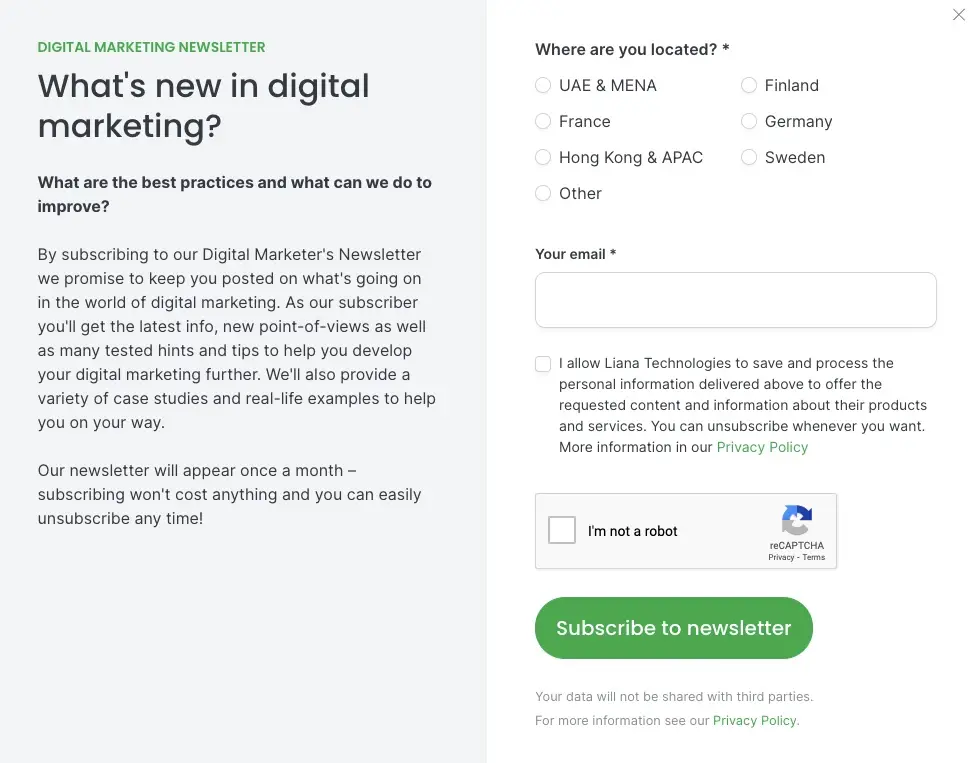The year 2025 brings marketers new opportunities to utilize marketing automation more comprehensively and customer-oriented.
In this article, we introduce the most important marketing automation trends 2025. We also provide practical tips for mastering the trends so that you can implement them as part of your daily work.
Understanding and adopting these trends will help you stay competitive and offer even better experiences for your customers.
Marketing Automation Trends 2025
- Seamless experience across all channels – omnichannel automation
- Next level personalization
- Data privacy and responsibility as key strengths
- Using AI more effectively in marketing automation
- Predictive analytics as part of everyday automation
- Responsible and sustainable marketing automation
1. Seamless experience across all channels – omnichannel automation
Customers expect an even smoother and more consistent experience across different channels. In 2025, the focus of marketing automation is on an omnichannel approach.
Omnichannel marketing means a strategy where the customer is met consistently across different channels, regardless of where or how they interact with the brand. Read more in our article What on earth is omnichannel?.
Automation tools aim to better integrate different channels to create a consistent and coherent customer experience. These channels can include, for example, email marketing, text messages, WhatsApp messages, social media, and websites.
How to master the trend
- Know your customer: Find out which channels your customers spend the most time on and how they prefer to interact. Adjust your automation content and messages based on this data.
- Make use of integrations: The power of omnichannel marketing lies in integrations. Check which integrations your automation tool supports and ensure you use all available channels. This creates a consistent customer experience and enhances marketing efforts. The integration of marketing automation and CRM also plays a significant role in the success of personalization.
- Communicate consistently: Ensure that your message stays the same regardless of the channel. However, consider the specific characteristics of each channel.
- Optimize: Monitor your automation tool's analytics and optimize your messages based on which channels and content yield the best results. Use A/B testing and your automation tool's statistics.
2. Next level personalization
In 2025, marketing automation's personalization methods have become even smarter, allowing marketers to respond to customers' needs even before they realize them.
Automation tools use customer data to create dynamically changing content that responds to customer behavior in real-time. Content can be automatically tailored based on the recipient's interests, location, or even the weather.
For example, website personalization can be based on segments created in the marketing automation tool. You can create customized website views for different segments that offer relevant and needs-based content. This takes personalization beyond typical adjustments, such as location or currency.
How to master the trend
- Walk through the customer journey: Analyze the customer journey and define the touchpoints where automation can be utilized. This helps create personalized and relevant experiences for customers.
- Use segments: Use customer data, such as purchase history and website behavior, to create automations that provide tailored messages for each customer.
- Dynamic content blocks: Use dynamic content blocks in newsletters, which automatically update based on the user's location, purchase history, or website behavior.
- Create trigger automations: Set triggers in your automation chains that activate based on certain user actions (e.g., abandoned carts, product views). This enables quicker and more effective responses to customer actions.

To effectively personalize your automation content, you need accurate data about your contacts. One way to achieve this is by using your sign-up form for segmentation purposes as well.
3. Data privacy and responsibility as key strengths
The importance of privacy protection continues to grow, and trust has become a key competitive advantage in marketing. Consumers want to ensure that their information is protected and that brands respect their privacy.
Building trust is vital in marketing automation. Operations must be transparent, and customers must be able to control their own data. Data-responsible marketing automation is not just an obligation; it can provide a competitive edge over competitors.
How to master the trend
- Act ethically and responsibly with data: Ensure that your automation complies with ethical principles and data protection laws. Ensure that your automation complies with ethical principles and relevant data protection laws, such as GDPR, the DIFC Data Protection Law in Dubai, or the Personal Data (Privacy) Ordinance in Hong Kong.
- Collect and store personal data properly: Collect and update opt-ins and provide an easy way to unsubscribe from lists. Ensure that the personal data you collect is properly protected. Store data in a securely proven tool instead of files saved on a computer.
- Communicate transparently: Clearly explain how you use customers' data and give them the ability to easily manage their own data. The clearer you communicate about data collection, processing, and storage, the more trust you build.
- Follow the legislation: New data protection regulations are being drafted, which may directly affect how marketing automation can be utilized. Stay up to date with legal changes and ensure that you always comply with current regulations.
4. Using AI more effectively in marketing automation
Artificial intelligence continues to revolutionize marketing, and its role is growing in marketing automation. In 2025, we will likely see even more advanced AI-based features in marketing automation tools.
AI is increasingly involved in various aspects of marketing automation: it helps with personalization and content automation, campaign optimization, large-scale data analysis, predictive analytics, and strategy creation.
How to master the trend
- Test the AI features of your automation tool: If AI is still new to you, it's a good idea to start small. Many marketing automation tools offer built-in AI features that you can easily use without in-depth AI knowledge. For example, with LianaAutomation, you can create newsletter content with the help of AI.
- Follow the development and trends of AI: AI is developing rapidly, so it's good to stay up to date with the latest tools and trends. You can find up-to-date information in the Guide to AI for Marketing and PR Professionals.
5. Predictive analytics as part of everyday automation
As AI develops, predictive analytics is emerging as a significant marketing automation trend in 2025.
Predictive analytics can be used, for example, to estimate when a customer is ready to repurchase or when they are at risk of losing interest. This gives marketers the ability to be one step ahead: communications can be targeted more accurately at the right time, and the customer experience can be improved.
Predictive analytics can also help forecast the results of automation campaigns and optimize the marketing budget.
How to master the trend
- Keep your data up to date: Predictive analytics works best when based on accurate and up-to-date data. Ensure that your customer and marketing data is well-organized and regularly updated so that analytics can provide reliable predictions.
- Use external AI tools: Although the analytics of automation tools is developing rapidly, you can complement them with separate AI programs to get even more accurate predictions and new insights.
- Automate customer segment activation: Predictive analytics can help identify customers who are ready to make a purchase decision or those whose interest is waning. Create automations that activate these segments with timely communications.
6. Responsible and sustainable marketing automation
In 2025, customers expect brands to act responsibly and take concrete actions towards sustainability. Marketing automation helps companies communicate their sustainable practices effectively and widely.
Automation enables targeted communication about the company's environmentally friendly choices and values, ensuring that the right message reaches customers who appreciate responsibility.
Responsibility also extends to the practices of marketing automation itself. While cloud services are often resource-saving, marketing automation activities also have environmental impacts, such as server electricity consumption and data traffic energy consumption.
A responsible marketer can reduce these impacts by optimizing campaigns, sending only necessary messages, and ensuring that communications are precisely targeted to the right customer groups.
How to master the trend
- Communicate about responsibility in your automation messages: Communicate to your stakeholders about the actions your company is taking toward responsibility. For example, you can include short updates on your company's sustainability practices and choices in your automation messages.
- Make data responsibility part of everyday life: Ensure that your company follows data-responsible practices in marketing as well. This includes, for example, deleting unnecessary data, respecting customer rights, and sending only relevant messages.
- Optimize resource usage in automations: While individual automation messages or campaigns may not feel heavy on the environment, they can matter on a larger scale. Focus on the quality of your communications over quantity, and carefully analyze which messages produce the desired results. Optimizing automations reduces unnecessary communication and thus minimizes environmental impact.
How to prepare your team for the adoption of new trends and practices?
Now that you know about the automation trends, it's time to consider which of them would be suitable for your use to support your business and its goals. Following trends is, of course, not mandatory or an end in itself, but they help you get the most out of your automation tool.
Invest in the right tools and technology
Staying up-to-date is easier when you have an automation tool that is actively being developed.
Evaluate the tool you are using: what are its potential shortcomings or needs? Can you adopt new trends with your tool?
If you are looking for a new tool for marketing automation, choose a platform that can be easily integrated with new technologies. This ensures that you can adapt quickly to changing market conditions.
Train your personnel
Marketing automation is evolving, and those involved need to keep up with the development. Maintaining and updating skills through training, for example, helps understand how new tools can be used effectively.
Following industry events and publications, reading expert blogs, and networking with other professionals also helps keep knowledge up-to-date.
Ensure that your team has clear roles and responsibilities for implementing marketing automation. If necessary, you can also consider outsourcing marketing automation or partnering with an expert.
Focus on data and its quality
The fuel for marketing automation is high-quality and up-to-date data, so investing in data collection, storage, and maintenance is worthwhile. When segmentation and personalization are used in automation campaigns, the data is put to real, effective use.
LianaAutomation – a trend-following tool for marketing automation
LianaAutomation is a data-responsible and continuously developing marketing automation tool that allows you to carry out omnichannel and personalized automation campaigns, either independently or with the help of our experts. LianaAutomation is part of Liana Cloud, which offers the most important tools for marketing and communication in one platform.





Comment
Comments
No comments